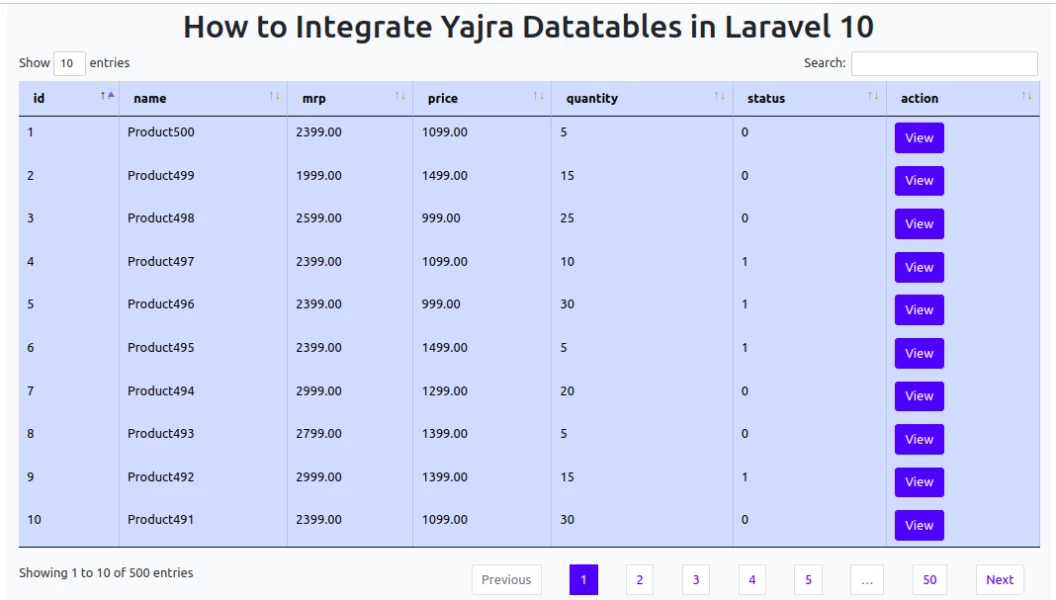Laravel 10 Yajra Datatables Integration Tutorial
Last Updated: 29 Jan, 2024In this tutorial, you will learn How to Implement Laravel Yajra Datatables in Laravel 10 Application. Laravel Yajra DataTables is a package that allows you to handle the server-side works of DataTables using Laravel. Yajra Datatables is a jQuery DataTables API that is used to handle server-side functionalities of jQuery DataTables plugin via AJAX option. It works very well with Eloquent ORM and Query Builder. To acheive this, you will be installing yajra/laravel-datatables-oracle composer package.
How to Integrate Laravel Yajra Datatables in Laravel 10?
Step 1: Install a New Laravel 10 Application
First of all, let's install a latest laravel 10 application in your local. Open a new tab in your terminal and please run the following command:
composer create-project laravel/laravel l10yajradatatables
Step 2: Configure Database Connection
Next, let's modify these database configuration variables in .env file as follows:
DB_CONNECTION=mysql
DB_HOST=127.0.0.1
DB_PORT=3306
DB_DATABASE=l10yajradatatables
DB_USERNAME=dbusername
DB_PASSWORD=dbpassword
Step 3: Install Yajra Datatables Package
Next, install yajra/laravel-datatables-oracle composer package to have Yajra Datatables feature in our application. To install this package, run below command in terminal:
composer require yajra/laravel-datatables-oracle:"^10.0"
Once you are done with Yajra Datatables package installation, register the DatatablesServiceProvider in the config/app.php file as follows:
<?php
use Illuminate\Support\Facades\Facade;
use Illuminate\Support\ServiceProvider;
return [
...
...
/*
|--------------------------------------------------------------------------
| Autoloaded Service Providers
|--------------------------------------------------------------------------
|
| The service providers listed here will be automatically loaded on the
| request to your application. Feel free to add your own services to
| this array to grant expanded functionality to your applications.
|
*/
'providers' => ServiceProvider::defaultProviders()->merge([
/*
* Package Service Providers...
*/
Yajra\DataTables\DataTablesServiceProvider::class,
/*
* Application Service Providers...
*/
App\Providers\AppServiceProvider::class,
App\Providers\AuthServiceProvider::class,
// App\Providers\BroadcastServiceProvider::class,
App\Providers\EventServiceProvider::class,
App\Providers\RouteServiceProvider::class,
])->toArray(),
/*
|--------------------------------------------------------------------------
| Class Aliases
|--------------------------------------------------------------------------
|
| This array of class aliases will be registered when this application
| is started. However, feel free to register as many as you wish as
| the aliases are "lazy" loaded so they don't hinder performance.
|
*/
'aliases' => Facade::defaultAliases()->merge([
// 'Example' => App\Facades\Example::class,
'DataTables' => Yajra\DataTables\Facades\DataTables::class,
])->toArray(),
];
Next, you can also run below command which is optional:
php artisan vendor:publish --provider="Yajra\DataTables\DataTablesServiceProvider"
Step 4: Create Product Model & Migration
Next, lets create a model named Product and migration for it using below php artisan make:model command:
php artisan make:model Product -m
Above command will create a model file named app/Models/Product.php and a migration file named database/migrations/*_create_products_table.php. Open the migration file and copy below code in it:
<?php
use Illuminate\Database\Migrations\Migration;
use Illuminate\Database\Schema\Blueprint;
use Illuminate\Support\Facades\Schema;
return new class extends Migration
{
/**
* Run the migrations.
*/
public function up(): void
{
Schema::create('products', function (Blueprint $table) {
$table->id();
$table->string('name');
$table->decimal('mrp', 8, 2)->default(0.00);
$table->decimal('price', 8, 2)->default(0.00);
$table->unsignedInteger('quantity')->default(0);
$table->unsignedTinyInteger('status')->default(0);
$table->timestamp('created_at')->useCurrent();
$table->timestamp('updated_at')->useCurrent()->useCurrentOnUpdate();
});
}
/**
* Reverse the migrations.
*/
public function down(): void
{
Schema::dropIfExists('products');
}
};
once you are done with model and migration files, let's run the below command that will run the laravel migration and create the tables in MySQL DB:
php artisan migrate
Open the Models/Product.php file and copy the below given code onto it:
<?php
namespace App\Models;
use Illuminate\Database\Eloquent\Factories\HasFactory;
use Illuminate\Database\Eloquent\Model;
class Product extends Model
{
use HasFactory;
protected $fillable = [
'name',
'mrp',
'price',
'quantity',
'status'
];
}
Step 5: Create ProductSeeder and Insert Dummy Records
Next, we will be using laravel seeder to seed products table with sample records. Use below command to create ProductSeeder.php
php artisan make:seeder ProductSeeder
Open the database/seeders/ProductSeeder.php file and copy the below given code onto it:
<?php
namespace Database\Seeders;
use Illuminate\Database\Console\Seeds\WithoutModelEvents;
use Illuminate\Database\Seeder;
use App\Models\Product;
class ProductSeeder extends Seeder
{
/**
* Run the database seeds.
*
* @return void
*/
public function run(): void
{
Product::truncate();
foreach (range(1,500) as $index) {
Product::insert([
'name' => 'Product'.$index,
'mrp' => fake()->randomElement([1999.00, 2199.00, 2399.00, 2599.00, 2799.00, 2999.00]),
'price' => fake()->randomElement([999.00, 1099.00, 1199.00, 1299.00, 1399.00, 1499.00]),
'quantity' => fake()->randomElement([5, 10, 15, 20, 25, 30]),
'status' => fake()->randomElement([1,0])
]);
}
}
}
Next, run the ProductSeeder using below command in terminal:
php artisan db:seed --class=ProductSeeder
Step 6: Create and Set Up Product Controller
In this step, we have to create ProductController by running below command in terminal that will create app/Http/Controllers/ProductController.php file.
php artisan make:controller ProductController
Next, open the app/Http/Controllers/ProductController.php and copy below code in it:
<?php
namespace App\Http\Controllers;
use Illuminate\Http\Request;
use DataTables;
use App\Models\Product;
class ProductController extends Controller
{
/**
* Display a listing of the resource.
*
* @return \Illuminate\Http\Response
*/
public function index(Request $request)
{
$view_data['title'] = 'How to Integrate Yajra Datatables in Laravel 10?';
if (!$request->ajax()) {
return view('products.index')->with($view_data);
} else {
$request_data = $request->all();
$products = Product::orderBy('id', 'desc')->get();
return Datatables::of($products)
->addIndexColumn()
->addColumn('action', function($row){
$actions = '<a href="javascript:void(0)" class="btn btn-primary">View</a>';
return $actions;
})
->rawColumns(['action'])
->make(true);
}
}
}
Step 7: Setup Product Routes
Next, open routes/web.php and copy below code in it:
<?php
use Illuminate\Support\Facades\Route;
use App\Http\Controllers\ProductController;
/*
|--------------------------------------------------------------------------
| Web Routes
|--------------------------------------------------------------------------
|
| Here is where you can register web routes for your application. These
| routes are loaded by the RouteServiceProvider within a group which
| contains the "web" middleware group. Now create something great!
|
*/
Route::get('/', function () {
return view('welcome');
});
Route::get('/products', [ProductController::class, 'index']);
Step 8: Create Product Blade Files
Next, create resources/views/products/index.blade.php file and copy below code in it:
<!DOCTYPE html>
<html>
<head>
<meta charset="utf-8">
<meta name="viewport" content="width=device-width, initial-scale=1">
<title>Laravel 10 Yajra Datatables Tutorial</title>
<meta name="csrf-token" content="{{ csrf_token() }}">
<link href="https://cdn.jsdelivr.net/npm/bootstrap@5.1.3/dist/css/bootstrap.min.css" rel="stylesheet" crossorigin="anonymous">
<link rel="stylesheet" type="text/css" href="https://cdn.datatables.net/1.10.21/css/jquery.dataTables.min.css">
<link rel="stylesheet" type="text/css" href="https://cdn.datatables.net/1.10.21/css/dataTables.bootstrap4.min.css">
</head>
<body>
<div class="container p-3 bg-light">
<div class="row text-center">
<h1>How to Integrate Yajra Datatables in Laravel 10</h1>
</div>
<div class="row">
<div class="col-12">
<table class="table table-primary table-bordered product-table">
<thead>
<tr>
<th scope="col">id</th>
<th scope="col">name</th>
<th scope="col">mrp</th>
<th scope="col">price</th>
<th scope="col">quantity</th>
<th scope="col">status</th>
<th scope="col">action</th>
</tr>
</thead>
<tbody>
</tbody>
</table>
</div>
</div>
</div>
<script type="text/javascript" src="https://ajax.googleapis.com/ajax/libs/jquery/1.9.1/jquery.min.js"></script>
<script type="text/javascript" src="https://cdnjs.cloudflare.com/ajax/libs/jquery-validate/1.19.0/jquery.validate.min.js"></script>
<script type="text/javascript" src="https://cdn.jsdelivr.net/npm/bootstrap@5.1.3/dist/js/bootstrap.min.js"></script>
<script type="text/javascript"src="https://cdn.datatables.net/1.10.21/js/jquery.dataTables.min.js"></script>
<script type="text/javascript" src="https://cdn.datatables.net/1.10.21/js/dataTables.bootstrap4.min.js"></script>
<script type="text/javascript">
$(function () {
var table = $('.product-table').DataTable({
processing: true,
serverSide: true,
ajax: "{{ url('products') }}",
columns: [
{data: 'DT_RowIndex', name: 'DT_RowIndex'},
{data: 'name', name: 'name'},
{data: 'mrp', name: 'mrp'},
{data: 'price', name: 'price'},
{data: 'quantity', name: 'quantity'},
{data: 'status', name: 'status'},
{data: 'action', name: 'action', orderable: true, searchable: true}
]
});
});
</script>
</body>
</html>
Step 9: Run Laravel Application
Next, run below artisan command in terminal to start laravel development server:
php artisan serve
Step 10: Test Application in Browser
Finally, open browser and check below url and test your application:
http://127.0.0.1:8000/products
Application OUTPUT

Recommended Posts

Laravel 10 CRUD Application Tutorial for Beginners
In this simple and comprehensive tutorial you are going to learn how to install Laravel 10 and create a New Laravel 10 CRUD Application.
Laravel 10 Multiple Guards Authentication Application Tutorial
This tutorial will provide you a clear understanding of how can you setup a multiple authentication guards application in Laravel 10 with the help of examples.
Simplified Laravel 10 Image Upload Application Using Spatie Media Library
This tutorial will provide you step-by-step guidance How to Upload Images Using Spatie Media Library in Laravel 10 Application.